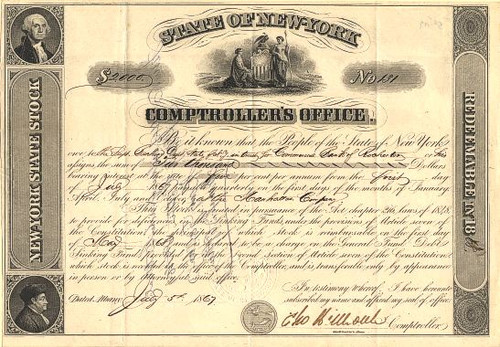Beautiful $100 Bond certificate from the Conversion Office for German Foreign Debts printed in 1936. This historic document has an ornate border around it with a vignette of a man and woman worker sitting with the silhouette of a building under construction in the background. This item has a printed signature with the raised Nazi seal and is over 83 years old. Written in English and German. 
Certificate Vignette Federal Reserve Bulletin April 1934 FOREIGN BANKING AND BUSINESS CONDITIONS ANNUAL REPORT OF THE GERMAN REICHSBANK The annual report of the German Reichsbank for the year ended December 31, 1933, was submitted to the general meeting of shareholders on March 9, 1934. The main text of the report is given herewith:1 The year 1933 witnessed not only political changes in Germany but also the beginning of economic recovery, which has been so long awaited. The complete confidence of the German people in their leader enabled the Government to make a systematic attack on the economic depression, and within a short time to achieve extraordinary results. Measures for creating work, reduction of taxes, and other means reduced the number of unemployed by more than 2 million. The revival of the spirit of enterprise laid the foundations of genuine business recovery. In spite of a further contraction in foreign trade, production and turn-over increased in many important lines and the income and purchasing power of agriculture was strengthened. Medium-sized industries, hitherto neglected but now under the special protection of the State, were able to strengthen their position and the number of insolvencies declined sharply. The revenues of the Reich showed a rising trend in spite of numerous tax reductions, and expenditures for the relief of the unemployed declined considerably. The burden of interest was somewhat lightened through a more abundant flow of funds, through improvement in credit risks in general, and through Government action. In contrast].with earlier years, the tasks intrusted to the Reichsbank were made appreciably easier by the support of governmental authority and the improvement in business confidence, so that it could employ far greater initiative than before in aiding recovery. Money market and credit policy.--The increase of domestic deposits with credit institutions was encouraging; credit requirements The report, available in German, contains, in addition, tables and charts showing the operations of the bank in detail. For earlier reports, see BULLETIN for May 1933, April 1932, August 1931, May 1930, etc. arising out of the business revival could be met with little additional demand on the central bank; and the sale of treasury bills and obligations by the Reichsbank was very active. Nevertheless, credit requirements were always so large in proportion to funds available on the money market that interest rates for shortterm loans underwent no very great reduction. It will not be possible for any marked reduction to take place until the volume of funds flowing into the market corresponds to the demand. The same thing is true of the demand for longerterm credit. In spite of the noteworthy increase in deposits at the savings banks, amounting to almost Rm. 900,000,000 during 1933, there was still a great dearth of investment capital. This is the underlying reason for the high level of interest in this section of the German market. The Reichsbank met the demand for longer-term credit, so far as practicable, with interim credits to tide over the emergency. The bank and the Government were in complete agreement that maintenance of currency stability is essential to the continuous success of the recovery measures and that every kind of credit expansion must be strictly controlled. The Reichsbank was likewise able to arrange interim credits in behalf of the various projects to create employment, which could be financed neither by taxes nor by loans. The Government and the Reichsbank were careful that these demands for credit should not fall directly upon the Reichsbank. It was felt that any use of funds for creating work could be justified only insofar as these funds were not diverted from other productive purposes. In order to reduce costs, the previous method of financing through bank consortiums was gradually abandoned. Bills for creation of employment, which are redeemable out of current Government funds, are acceptable for rediscount at the Reichsbank and are a premier bank investment. As a result the Reichsbank held at the end of the year less than half a billion reichsmarks, or about one third of the outstanding total of these bills, the remainder being held almost entirely by the banks. The method of lending to agriculture underwent considerable change owing to measures taken by the Government for relieving indebtedness. The Reichsbank made an effort to ease the temporary difficulties arising out of the change. Funds required for financing the harvests and for other purposes were made available, chiefly through the central credit institutions for agriculture. Seasonal credits for the sugar industry, which before the crisis were arranged chiefly in foreign financial centers, are now provided by the Reichsbank in the regular course of business. Generally speaking, the volume of funds made available to business in various ways by the Reichsbank was larger in 1933 than in 1932. A considerable increase took place in the portfolio of domestic bills as a result of the improvement in business. The emergency credits growing out of the monetary crisis of 1931 were sharply reduced, chiefly as a result of the improved position of the savings banks, and bills at the Acceptance Bank declined by more than half, whereas commercial credits rose. The greater buying of forward drafts for hedging purposes benefited German export trade. Few demands were made upon the bank for credits to finance deliveries of German merchandise to Russia, and the Reichsbank holdings of Russian bills have declined. During the year complaints with respect to inadequate credit accommodation were received from time to time from the most diverse lines of business. The Reichsbank looked into every case that came to its attention. In most cases where the applicant could prove that he was responsible and that the credit was to be used for commercial purposes, assistance was afforded. Gold and foreign exchange.--In order to clear up its position, the Reichsbank decided in April 1933 to repay the remainder of the foreign credit of $70,000,000 which it had obtained in June 1931; and in June 1933 to repay the remainder of the foreign credit of the Gold Discount Bank, amounting to $45,- 000,000. From the outset these credits had accomplished nothing more than a purely nominal improvement in the reserve against note circulation; their repayment in no way weakened Germany's international capacity to pay, but rather strengthened it by saving interest. The long-standing weakness of the German foreign-exchange position was now evident to all the world. Inasmuch as currency and trade policies abroad suggested no improvement, Germany, in this field too, proceeded to find its own solution. To regulate transfers on the service of the foreign debt, the Government of the Reich on June 9, 1933, issued regulations with respect to payments on foreign obligations (Reichsgesetzblatt I, p. 349). These required German debtors to make regular payments in reichsmarks, on and after July 1, 1933, on all claims outstanding previous to the crisis of July 1931, so far as they were not covered by standstill agreements. Payment was to be made to the Conversion Office for German Foreign Debts, which was under the supervision of the Reichsbank, and the Reichsbank was authorized to determine when disbursements should be made from the balances created at the Conversion Office in behalf of the creditors. After lengthy negotiations with representatives of foreign creditors, who recognized that a strengthening of the gold and foreign-exchange holdings of the Reichsbank was necessary in their own interests, the bank determined to suspend all transfer of sinking-fund payments; and of the interest and dividends falling due in the second half year of 1933 to transfer only one half, but not over 4 percent per annum. In the case of the Dawes and the Young loans special arrangements were made. Noninterest-bearing certificates of indebtedness of the Conversion Office (scrip) in denominations of from 5 to 100 reichsmarks were delivered for the remaining interest balances in the accounts of creditors. All trading by means of scrip, like the trading done through the various kinds of blocked marks, was centralized in the Gold Discount Bank, which bought scrip from foreign holders at half its face value and delivered it to German exporters. In this way it was possible to give the owners of these certificates the opportunity of converting them into cash, and also to afford the German export trade additional opportunities for export in competition with countries with depreciated currencies. The law of June 12, 1933 (Reichsgesetzblatt I, p. 360), in regard to economic treason gave exporters of capital and tax evaders one more chance to declare their illegal foreign balances and to convert their hoarded foreign exchange into reichsmarks. Because of the strength of the political situation at home, and the heavy penalties threatened for noncompliance, the law was successful in bringing about the surrender of approximately 100,000,000 reichsmarks. Including this special accession, the holdings of the Reichsbank in gold and foreign exchange eligible for note cover rose during the second half of 1933, but only by about 120,000,- 000 to 395,000,000 reichsmarks. In December 1933 the Reichsbank felt compelled under these circumstances to reduce the percentage of interest transfer for the first half of 1934 from 50 to 30 percent. A serious weakening of the foreign-exchange reserve of the Reichsbank was inevitable if the former arrangements were continued--wholly apart from the probable further deterioration in the balance of payments. After negotiations with foreign creditors, however, the Reichsbank agreed that the German Gold Discount Bank should purchase new scrip of the Conversion Office at the rate of 67 instead of 50 percent as before. In this way the holder of German foreign loans receives on the average more than three fourths of the nominal value of his interest coupons, which under present conditions represent excessively high rates. It was necessary to modify in many respects the methods of controlling foreign exchange. The flight of capital, temporarily increased as a result of the political revolution and the more recent export policy, made this imperative. The patrol of frontiers was tightened. During the year a series of foreign-exchange agreements were concluded, some of them between governments, some between central banks of the participating countries, and covenants already existing were amended or broadened. Using earlier arrangements as a model, the Reichsbank made new agreements in August for regulation of exchange transfers with the Turkish bank of issue as well as with the Bank of the Temple Society, Ltd., at Jaffa; in October an arrangement was made with Portugal. An understanding with Belgium for easing restrictions on tourists was reached in July. By amending existing regulations, new arrangements with Czechoslovakia were made in April for the transfer of payments with respect to merchandise transactions, and in October for the transfer of payments in other cases. A transfer agreement with Hungary was reached in August. Through the efforts of the Reichsbank German balances abroad that had been frozen as a result of foreign-exchange restrictions were further reduced. Standstill agreements.--The foreign indebtedness of Germany was again reduced by repayments and also as a result of the devaluation of the dollar and the depreciation of other important currencies. The aggregate shortterm foreign debts of Germany amounted to approximately 7,000,000,000 reichsmarks on September 30, 1933. Of this total, some 2,500,000,000 reichsmarks w^ere covered by standstill agreements. During the year covered by the standstill agreement that expired on February 28, 1934, the total volume of standstill indebtedness w^as reduced by about 1,250,- 000,000 reichsmarks, which includes the reduction arising out of currency depreciation. Of this amount, about 200,000,000 reichsmarks represented reductions provided for in the agreement, and about 500,000,000 repayments of registered marks. By the London negotiations in June which took account of the unfavorable foreign-exchange position, interest rates on the standstill credits were lowered by almost one half of 1 percent on the average; that is, to almost the same extent as by the renewal agreement last year. Moreover, the standstill creditors relinquished their contractual right to repayment out of the Reichsbank's holdings of foreign exchange, and agreed to a postponement of payment on the maturing installments of those credits which the Gold Discount Bank had undertaken to guarantee in exceptional cases by pledging the total assets of German business. By the German Credit Agreement of 1934, representing a 1-year renewal of the standstill, the postponement was extended to instalments of the Gold Discount Bank falling due in the future, and any reduction of credit lines was waived. Similar arrangements were concluded during the past year in the Credit Agreement for German Public Debtors, 1933, the renewal of which is at present the subject of negotiations. Rate of reichsmark exchange.--The reichsmark in the foreign exchanges remained very close to parity throughout the year, and from time to time rose above par. Occasional slight periods of weakness, resulting from the illegal outflow of German funds to foreign countries, were quickly readjusted. The capital market.early in the year the capital market reflected the hesitation of investors toward long-term obligations. Subsequently, measures taken by the Government and Reichsbank to loosen up the capital market were successful in bringing about an upturn. By a cabinet decree of May 31, 1933, a commission under the chairmanship of the president of the Reichsbank was appointed with power to regulate and supervise all matters relating to the money and the capital markets. The adherence to the principle of currency stability and the rejection by the authorities of any further compulsory reduction of interest rates also helped to restore confidence. Recovery measures in behalf of agriculture safeguarded the interests of holders of mortgages. By the law of September 21, 1933, communal finances underwent a thorough reorganization through the consolidation of the short-term domestic debts of the communes at a rate of interest which, though moderate, was acceptable to the creditors (law of Sept. 21, 1933, Reichsgesetzblatt I, p. 647). The use of the open-market powers, authorized by the amendment of October 27, 1933, to the bank law (Reichsgesetzblatt II, p. 827) enabled the Reichsbank to participate actively in the capital, market. This assisted in narrowing the margin between the excessively high rates on the capital market and the low rates prevailing for short-term funds. There soon occurred a substantial rise in security quotations, and since the end of September a general and steady revival in the German stock exchanges. With faith in the new Government, the confidence of investors and capitalists increased; obligations of the Reich and the States approached parity or rose above it; city and communal obligations rose considerably above their depression quotations. The mere announcement of the bank law amendment was a factor of strength. By the middle of November the Reichsbank had acquired tax warrants in the amount of almost 200,000,000 reichsmarks, and by this means effectively relieved the tension at the banks and in the money market. Thereafter the Reichsbank continued to buy further moderate amounts of securities eligible as note cover, until at the end of the year its holdings reached 259,000,000 reichsmarks. In addition it eased the regulations with respect to collateral loans; this gave greater freedom of action to holders of securities eligible as collateral, and assisted the capital market. The conversion of dollar obligations into reichsmark loans, promoted by the Reichsbank, protected the creditor against further depreciation, gave the debtor a reduction of interest, and contributed to the strength of the capital market. Toward the end of the year the easing of the situation had progressed to such an extent that the Government was able to offer a voluntary conversion loan, though bearing a high rate of interest. Most of Germany's foreign obligations showed a temporary advance toward the end of the year from their previous low levels. The bank law.--After the consent of the Bank for International Settlements at Basel had been obtained, a law amending the bank law was approved by a special meeting of the shareholders of the Reichsbank on October 27, 1933. This law, taking account of the necessities of the time, is intended to give the German central bank greater freedom of action by means of open-market operations. The Reichsbank is given the right to buy and sell all descriptions of domestic securities eligible as collateral for loans under paragraph 21, sections 3b and 3c of the bank law, and to include in the legal note cover call loans secured by collateral. The General Council is abolished, inasmuch as it lost its reason for existence in 1930 upon the retirement of the foreign members. The president of the Reichsbank and the members of the board of directors will hereafter be appointed by the President of the Reich--the former with the advice of the directors of the Reichsbank, the latter on the suggestion of the president of the Reichsbank. They can at any time be recalled by the President of the Reich for sufficient reason. The general meeting of shareholders, at the suggestion of the board of directors of the Reichsbank, decided at the same time to change the bylaws so that in future, with the consent of the central committee of the Reichsbank, a part payment may be made on October 1 (in 1933 on Nov. 1) up to 6 percent--that is, up to three fourths--of the minimum dividend guaranteed by law. Banking investigation.--For the purpose of restoring an effective banking and credit system, the German Committee of Banking Inquiry 1933, composed of 15 members under the chairmanship of the president of the Reichsbank, was appointed by the Government. The committee convened in public session for the first time on September 6. In preparation for these discussions, individual opinions of qualified experts regarding the problems to be considered had been carefully worked out, and the statistical material prepared in the Reichsbank in collaboration with the Statistical Office of the Reich was made available. On November 21 the committee began its regular work, and the individual problems were taken up one after the other, sometimes in public sessions, sometimes privately. In dealing with this farreaching work of reform, which touches all business groups so deeply, the strong desire for recovery was reflected in a new spirit of solidarity. The results of the inquiry will shortly be submitted to the Government in the form of recommendations.

Certificate Vignette








